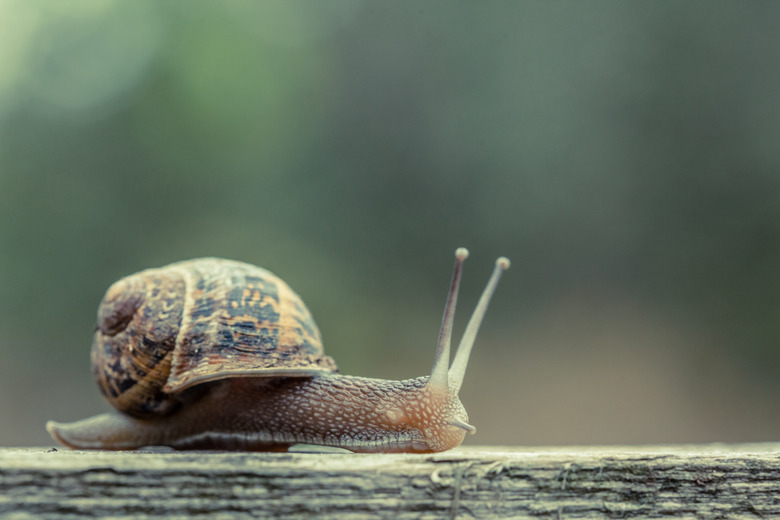A List Of Mollusks
Mollusks consist of a wide range of invertebrate animals, from snails to giant squids. A mollusk usually has a soft body that is covered with an exoskeleton, such as the shell of a clam. Just what sort of animal qualifies as a mollusk is up for debate, with some research classifying 50,000 species and others up to 200,000. However, three groups of animals are almost always included in molluscs lists: gastropods, bivalves and cephalopods.
Gastropods
Gastropods
Snails and slugs make up the majority of the gastropod family. Gastropods are the largest family within the mollusk classification, with as many as 80% of all mollusk species being gastropods. Many of these creatures have a protective shell that covers most of their body. They are known for having a single "foot" that helps propel them over the ground, though some can also move through water and even burrow. Gastropods are also known for their strange body shapes, caused by "torsion," which occurs in the early stages of development. During torsion the majority of the gastropod's body mass is twisted, which results in the anus being positioned over the head. The digestive and nervous systems are also twisted.
Bivalve Mollusk
Bivalve Mollusk
The bivalve family of mollusks consists primarily of clams, scallops and other ocean creatures that have a hinged shell. That hinged shell is the hallmark of bivalves, and the shell is produced by the mollusk itself. As it grows, the mollusk secretes calcium carbonate, constantly rebuilding the shell. Bivalves also use a "foot" for locomotion — a protuberance of flesh that is used to push against the ocean floor. There is thought to be at least 9,200 different species, many of which are edible. Over 150 million pounds of bivalves were harvested in 2011.
Cephalopods
Cephalopods
Cephalopods include octopi, squid and nautiluses. Unlike the tiny gastropod and bivalve types of mollusca, cephalopods like the giant squid can grow to lengths of 59 feet (18 meters). Cephalopods typically have three hearts which beat blue, copper-binding blood throughout their bodies. Cephalopods also have the largest brains of any invertebrate, and it's been shown that they are capable of learning. These creatures also have an ink sac that can be used to blind predators, giving the cephalopod a chance to escape.
Other Mollusks
Other Mollusks
Certain animals share characteristics with mollusks but are not always classified as such. An example is the monoplacophora, an ancient creature that was thought to be extinct until a living specimen was found in 1952. It is thought that these clam-like animals were the progenitors of all other types of mollusks. Another type is the chiton, or polyplacophores, which has been around for at least 500 million years. Scaphopods are another ancient type of mollusk, which emerged around 550 million years ago. As more sophisticated technology emerges to aid scientists in animal classification, these creatures and perhaps many more may officially be included in the list of mollusks.
References
- University of California Museum of Paleontology: The Mollusca
- University of Michigan: Gastropoda
- National Oceanic and Atmospheric Association: Bivalve Mollusks (e.g., Clams, Oysters, Mussels, Scallops) Have an External Covering that Is a Two-Part Hinged Shell that Contains a Soft-bodied Invertebrate
- University of California Museum of Paleontology: The Monoplacophora
Cite This Article
MLA
Michelle, Meg. "A List Of Mollusks" sciencing.com, https://www.sciencing.com/list-mollusks-8700474/. 25 July 2018.
APA
Michelle, Meg. (2018, July 25). A List Of Mollusks. sciencing.com. Retrieved from https://www.sciencing.com/list-mollusks-8700474/
Chicago
Michelle, Meg. A List Of Mollusks last modified March 24, 2022. https://www.sciencing.com/list-mollusks-8700474/
